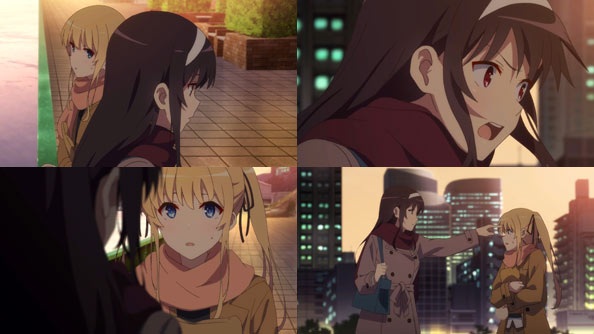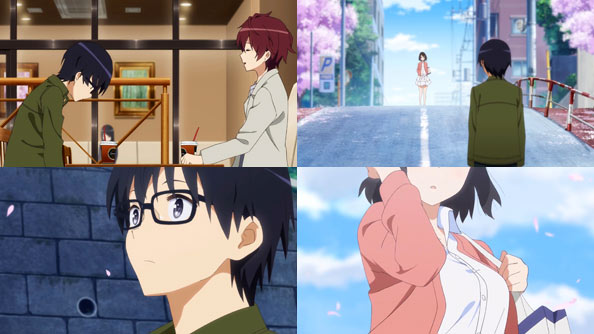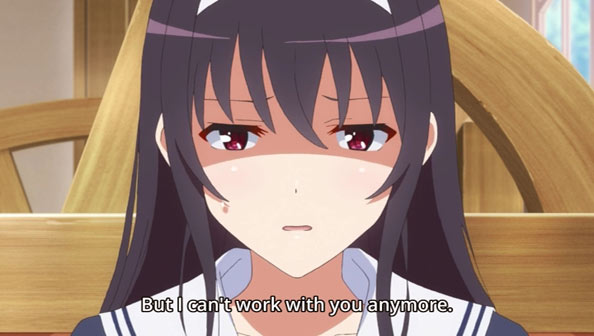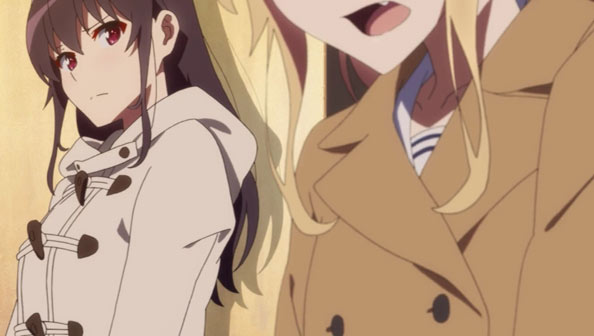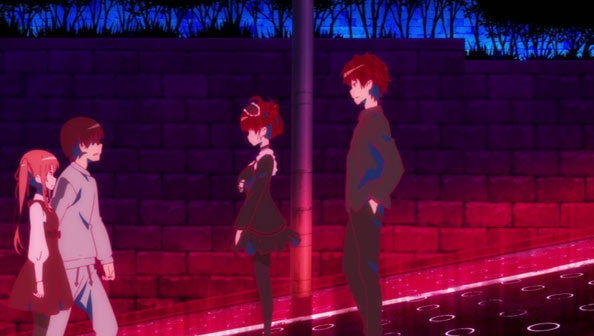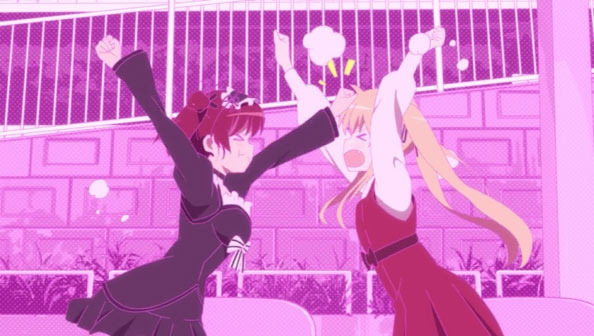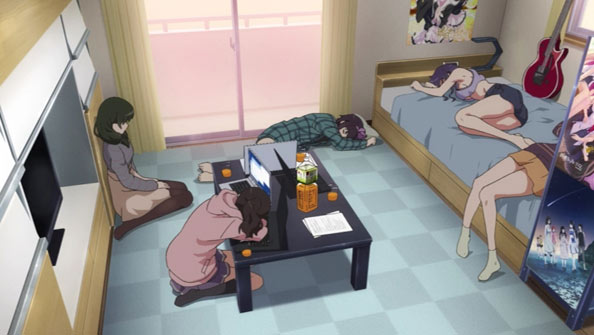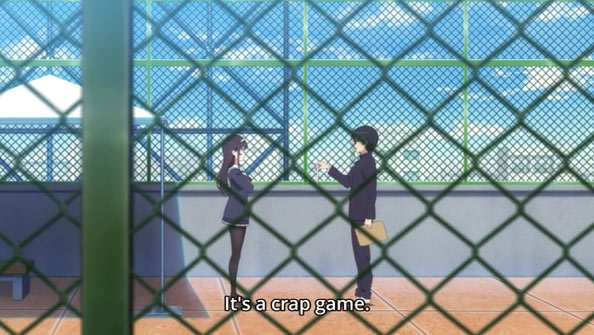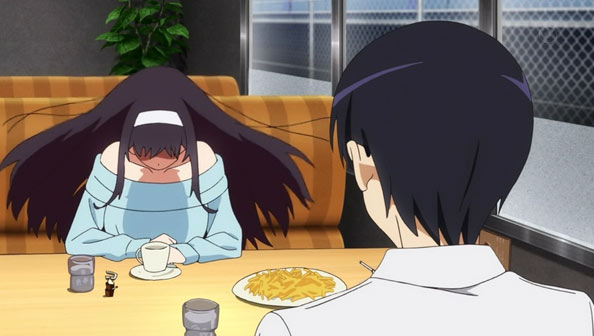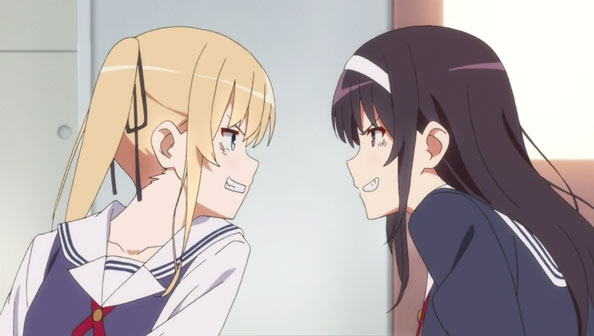It’s very rare indeed for an episode to come around that gives you everything you wanted; everything you held out hope would come to pass but didn’t dare expect. And yet, well, here we are.
The completion of Cherry Blessing was an arc closure at an odd time in the run of a season, but the groundwork that was laid thereafter pays off wonderfully here, as Kashiwagi Eri decides to Take Her Talents to Rouge Beach, thus enabling Kasumi Utako to come along for the ride.
We start in the aftermath of that hellish meeting with Akane, still shaken from the abuse they were forced to endure. Utaha is no less honest and upfront as Akane was: she’s steaming mad that she’s being treated as an afterthought; a James Jones, if you will.
But as much as she hates Akane for doing so, she still agrees with the producer that Eriri is many years too early and too green to presume she’s “in a slump.” If Eriri agrees to do Fields Chronicle, Utaha will strive to crush her, even as they collaborate.
Of course she does. Competition, even outside one’s own field, drives a creative like Utaha. She wouldn’t be who she is if she didn’t treat Eriri as a rival; and when such a massive job comes around such as this, her’s is the name she’ll want spoken first in praise of the game.
Eriri laments that Utaha is dumping such a huge decision on her alone, but Utaha points out she’s not the one doing the dumping; that’s Akane. Utaha never had a choice. But if Eriri says yes, she’ll work with her, and not just because she’ll be able to as part of the deal with Akane, but because she believes the two of them can move forward together.
Not long thereafter, Eriri calls Utaha out of the blue, inviting her to join her back at school, where Eriri announces she’s defeated her slump and has her drawing touch back.
She forgot to bring the sketches to prove it to a giddy, over-the-moon Utaha (who curses Eriri for being so damn useless), but Eriri doesn’t need them, and instead proves it by sketching then coloring a gorgeous portrait right before a stunned Utaha.
She is indeed back, and Eriri responds to Utaha’s approval with smiles and laughter, but those turn to bitter tears when Eriri thinks of the reason she can draw again. As much as she wanted it to be because Tomoya wanted her and because of his support and love, she can draw again because of the less-than two minutes Akane spent insulting her.
Akane’s tirade did what it was meant to do, whether Akane meant to do it or not: Rattle Eriri’s cage; rattle it until the latch slips loose and Kashiwagi Eri can be fully released from behind the iron bars of Tomoya’s safe, comfortable doujin group.
That place is no longer conducive to the creative growth required for Eriri to be as amazing as she can be—and as Tomoya said she could be. It’s a hard pill to swallow, but Eriri does so, and Utaha offers a comforting hug in the process. You heard right: Eriri and Utaha hug.
In return for her empathy, Eriri warns Utaha not to let Akane look down on her. Utaha had seemed thus far to be taking Akane’s words as gospel because she’s so experienced and successful, but Eriri, staunch Kasumi Utako fan, offers a different view: Akane “isn’t anything special” if she would so blithely underestimate Utaha’s talent.
That, in turn, elicits tears from Utaha, but she wipes them before bumping fists with Eriri, the first step on their new and exciting journey that is almost asssured to make them a part of video game history.
That leaves Tomoya Aki, whom I half-expected to blow his top and throw some kind of temper tantrum at the news that not only would Utaha be backing out of his group, but Eriri would too, thus “betraying” him for the second time in their long years together.
But I found that such a half-prediction was selling Tomoya short. He’s certainly not elated by the (off-camera) defections, but he’s a big boy, and he’ll get over it. I was pleased with how mature he acted, while Hashima Iori, who left rouge en rouge with Izumi for, presumably, the same reason Eriri and Utaha left Blessing (to grow), urges Tomoya not to quit game developing and creating just because he lost his two “golden geese.”
And I totally get why: Eriri and Utaha were just as much training wheels as geese; he’ll now have to test his producer mettle other people; creatives who may not be as hugely talented, and people who won’t be lured into working for him by the feelings they harbor for him!
But there’s another reason Tomoya will be just fine: his harem has been shattered, and with it all the myriad routes he could have chosen to take. Now there is one route, and it leads him up the same sakura-scattered hill, where a familiar figure seems to be waiting for him…
That figure is, naturally, Kato Megumi, the girl who is best suited for Tomoya, and always was; a girl he won’t be stifling creatively, because they work so well together. She’s returned to the short hair that first inspired Tomoya into making a video game about a nice, astonishingly ordinary, “boring” girl.
Tomoya, in turn, drew Eriri and Utaha into his orbit. Normal as she may sound and appear, without Megumi there’s no Blessing Software, no Cherry Blessing, and no Fields Chronicle offer. She was their heroine, the heroine, and now he’s his. And like any good heroine, she makes the first move, suggesting they go out on a date at once.
Sounds good to me! Well done, show: Satisfying resolutions, character growth, and so many feels.


